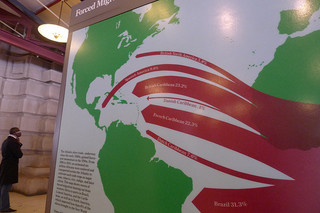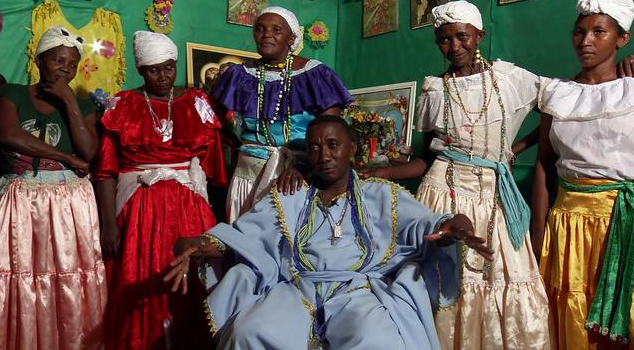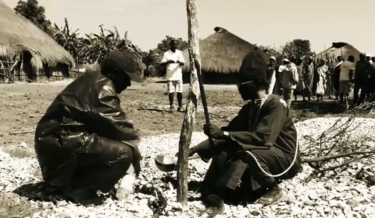A few days after the Brazilian government suspended for five months the reinstatement of ownership requested by the Brazilian Navy of the land of the Quilombo Rio dos Macacos in Bahia – one of the oldest communities of slave descendants in Brazil, inhabited by around 75 families [pt] -, on the other side of the Atlantic, in Lisbon, the international conference “The Passage of the Quilombos: from Africa to Brazil and the return to origins” [pt] was held at the beginning of March. This meeting saw the release of the documentary Kilombos, produced by the Portuguese journalist Paulo Nuno Vicente, and described [pt] by him on the website ‘Buala’ as “a rescue film about the Quilombos of Brazil”, which “transports us through the oral history of the African roots of the Quilombo communities, showing the intersection of these roots with contemporary cultural practices”.
O sentido de pertença a uma identidade extravasa a fronteira do medo. Ser quilombola é estar para lá do lugar. Uma imagem perdura para lá do que representa. «Kilombos» é uma tentativa de cartografia antropológica para os antagonismos do Brasil contemporâneo, metonímia oral do globalizante e do ancestral em fluxo.

31.3% of African slaves were transported to Brazil. Photo by Hollywoodsmille78 on Flickr (CC BY-NC-ND 2.0)
The documentary, filmed mainly in the Brazilian state of Maranhão, but also in Cape Verde and Guinea-Bissau, forms part of a triannual project[pt] promoted by the Portuguese NGO Instituto Marquês Vale de Flor (IMVF), in partnership with local organisations:
A escolha destes três países reside no seu passado histórico comum. Os navios que transportavam a mão-de-obra escrava vinda da costa africana rumo ao Brasil fazia a sua primeira paragem em Cabo-Verde. Esta rota marítima, que ligou os três territórios há mais de quatro séculos, deixou marcas ainda hoje visíveis. Estes navios não transportavam para o Brasil apenas homens e mulheres africanos, transportavam igualmente tradições, crenças e costumes, ainda hoje respeitados e praticados nos três países.
Since Cape Verde was populated by Portuguese settlers in the second half of the 15th century, the islands have served as “a turntable for the slave trade between Africa and America”, says José Semedo, from Praia, in an interview [pt] for the documentary ‘Kilombos’. “According to data from that time, half of the African slaves who arrived in Maranhão between 1774 and 1799 were taken from Guinea-Bissau”, notes[pt] Eduardo Mello, from the blog Jovens Diplomatas (Young Diplomats), in a text which gives his impressions on the return of the Quilombolas to their origins in Cacheu three centuries later, funded now by the IMVF project.
“We witness and suffer the black holocaust”, comments[pt] Mello on the celebration at Cacheu, in which a play was staged depicting the trafficking of slaves in the 17th century, protagonised by descendants of African slaves themselves, the members of Quilombo communities in Maranhão – “in the horror of the ships, about to transform America and Brazil, they sang. They wept”:
Perto da sagrada Floresta de Cobiana, uma multidão celebra o reencontro com os retornados, que a cada frase, receita, som ou expressão, redescobrem origens e destinos. Hoje, a cidade está decorada com instrumentos musicais, artesanato, frutas, e histórias em comum. O cuxá, prato maranhense, é idêntico ao “baguitche” guineense – mas a etnia mandinga sempre chamou de cuxá mesmo. A noite começa a banhar em prata o caudaloso Rio Cacheu. As apresentações das etnias guineenses misturam-se às dos quilombolas brasileiros, à voz de Eneida Marta, e aos discursos. (…) Os grupos cantam, dançam, sobem em árvores, celebram o estranhamento de parentes separados pelos séculos. A matriz é guineense, mas muito mudou: nosso canto não é da e pra terra, é de procissão; o compasso marcado de cada etnia mestiçou-se, no Brasil, com a percussão de inúmeros outros povos do continente africano, no caldeirão dos entrudos (ou “N’tturudu”, como se diz aqui).
“The history of the Quilombos is one of liberty and dignity”
As Mello says, “a lot has changed” in the identity of this culture which, in the words [pt] of the producer of ‘Kilombos’, “crosses borders and brings continents closer together”. However, and returning to the Quilombo Rio dos Macacos mentioned in the opening paragraph of this article, the current struggle of the Quilombolas has shown that there is also a certain continuity in the violation of the human rights of these communities, such as the right to land. Alan Tygel, from Vírus Planetário [Planetary Virus], draws a historical parallel, and speaks of “modern practices” [pt] which transport us once again on a journey between times and territories:
O sol já vai se pondo, e os escravos aproveitam o fim de tarde na senzala para descansar da jornada extenuante. O trabalho no engenho de cana é duro. Açoitados, acorrentados, longe da terra natal, separados de suas famílias, os negros ainda assim jogam capoeira e cultuam seus orixás. Nesse mesmo dia, houve duas fugas na fazenda: Zé Preto tentou sair por trás das amendoeiras de baixo. Almeida, o capitão-do-mato, não teve muita dificuldade: o negro não tinha mais forças, fugiu por desespero. As chibatadas que levou ali mesmo, no mato, foram suficientes para encerrar seu sofrimento e levá-lo para a outra vida. Gangá não teve a mesma sorte: foi para o tronco, e deve ficar lá por dias. Para todo mundo saber o que acontece com escravo fujão. Num lugar não muito distante dali, cerca de 300 anos depois, a situação não mudou muito. Para os moradores do Quilombo Rio dos Macacos, foi como se a escravidão tivesse acabado e depois voltado. Alguns ainda possuem fotos de seus bisavós vestidos com trapos trabalhando na fazenda. Os mais idosos se lembram do jongo, da capoeira e do samba-de-roda na comunidade. Da época em que eram felizes, na sua roça, com seu pescado, sua dança e sua religião. Há cerca de 30 anos, voltaram a ser cativos.
A petition [pt] remains in circulation calling for ownership of the Quilombo Rio dos Macacos to remain with the Quilombolas, who have received a guarantee for now that they will not be expelled in the next four months, during which time the Incra (National Institute for Colonisation and Agrarian Reform) [pt] must conclude a Technical Report of Identification and Delimitation with the intention of determining for how long the land has been occupied.









1 comment